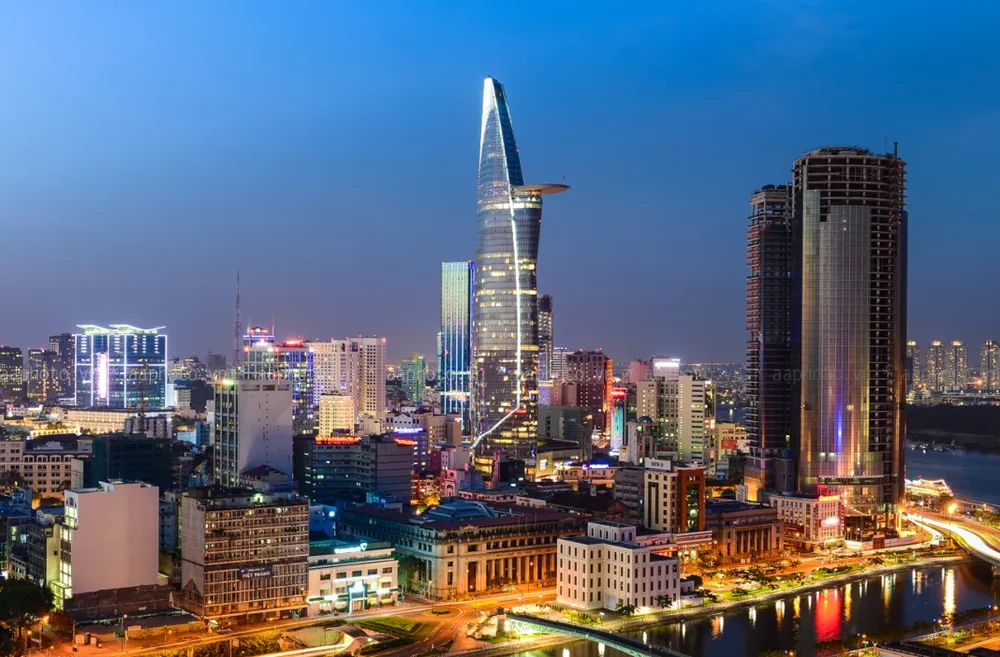
However, the year 2024 presents numerous challenges, prompting the city to implement comprehensive solutions aimed at stimulating aggregate demand and diversifying export markets to foster economic growth.
On the road to recovery
By the conclusion of 2023, Ho Chi Minh City's Gross Regional Product (GRDP) has exhibited a growth of 5.81%, with the service industry experiencing a notable increase of 6.79%, and the industrial sector recording growth at 4.42%. Despite an initial GRDP growth rate of 0.7% in the first quarter, the city has diligently implemented various solutions, resulting in positive growth rates of 5.87% in the second quarter and 6.71% in the third quarter. The "Ho Chi Minh City Macroeconomic Report: 2023 Results and 2024 Forecast," conducted by the University of Economics Ho Chi Minh City (UEH) and the Ho Chi Minh City Statistics Department, highlighted that although the set target was not fully achieved, the city's economy achieved noteworthy growth in 2023.
The research team analyzed that, as the largest economic center in the country, Ho Chi Minh City consistently achieves a growth rate higher than the national average, generating employment opportunities for millions of workers from all provinces and cities. Despite facing substantial impacts from the COVID-19 pandemic, Ho Chi Minh City's economy demonstrated a notable improvement in its GRDP growth rate throughout 2023. This reflects a stable recovery in the total demand for goods and services in the city's economy, particularly in the service, industrial, and construction sectors.
To provide a clearer perspective, let's delve into the data released by the Ho Chi Minh City Statistics Department. In 2023, the agricultural, forestry, and fishery sectors witnessed an increase of 1.53%. Simultaneously, the industrial and construction sector recorded growth at 4.42%, with the industry specifically growing by 4.41%. The commercial and service sector displayed a robust increase of 6.79%, while product tax experienced growth of 3.57%.
Apart from the real estate business, which reported a negative growth rate of 6.38%, all other industries showcased positive growth rates. Noteworthy sectors include wholesale and retail, witnessing a growth of 10.17%; transportation and warehousing, up by 7.64%; information and communication, marking a 5.94% increase; finance, banking, and insurance, growing by 5.69%; scientific and technological professional services, experiencing a 6.61% increase; education and training, with a growth rate of 7.03%; and medical and relief activities, growing by 3.24%. The accommodation and food service industry alone exhibited the highest increase at 16.38% compared to 2022.
The influx of new businesses entering the market in Ho Chi Minh City indicates a positive recovery trend. Total foreign direct investment (FDI) into the city surged by 48.5% over the same period. Experts also commented on the shift in FDI capital following the direction outlined in Resolution 98/2023/QH15 of the National Assembly, which pilots specific mechanisms and policies for city development. This shift involves prioritizing FDI investors engaging in high technology, digital platforms, and digital technology, particularly in fields related to the fourth industrial revolution such as semiconductor chips, new energy, biotechnology, renewable energy, and the environment.
Tried but must try harder
Despite the bright spots in Ho Chi Minh City's economy, challenges persist in 2024, requiring more time for adaptation and a gradual move toward recovery. Forecasts indicate that difficulties will likely persist, at least until the end of the second quarter of 2024. This is attributed not only to the general challenges of the global economy but also to the anticipated slowdown in the growth of the world's second-largest economy, China, in 2024. The deceleration in China's growth is expected to significantly impact Ho Chi Minh City's exports, given that China is a crucial export market for the city. This poses a challenge for Ho Chi Minh City in its efforts to stimulate the recovery of aggregate demand.
Dr. Hồ Hoàng Anh from UEH suggests that stimulating aggregate demand is an effective short-term measure to generate growth for Ho Chi Minh City. The pace of economic recovery, whether quick or gradual, is heavily dependent on the aggregate demand for goods and services. This encompasses the consumption needs of individuals, the requirements of businesses, and the disbursement of public investment by the State, all contributing to a faster and more robust recovery of aggregate demand. In addition to continuing public investment disbursement, Ho Chi Minh City can concentrate on policies aimed at promoting consumer spending, encouraging investment in asset accumulation by businesses and households, and boosting exports.
Dr. Trần Du Lịch, a member of the National Financial and Monetary Policy Advisory Council, has proposed that the Government utilize a combination of exports, the domestic market, and public investment to stimulate aggregate demand. Recent efforts to boost aggregate demand in the economy have involved a four-pronged approach, including continued innovation, domestic consumption, exports, and public investment. While export orders have rebounded, indicating potential improvements in 2024, challenges persist in the global market forecast. The disbursement of public investment, though considered a solution to stimulate aggregate demand, faces its own set of difficulties. The real estate market's impact on the broader market remains significant, and despite some progress, capital congestion persists.
Dr. Lịch emphasizes the need to tap into the domestic market to stimulate aggregate demand. The National Assembly's decision to extend the value-added tax reduction policy to 8% is currently in place. Banks are urged to continue expanding consumer credit, and national programs should be implemented to make shopping more accessible for various consumer classes.
Dr. Trần Anh Tuấn, Head of the Ho Chi Minh City Enterprise Management Innovation Board, suggests that the city concentrate on removing obstacles in public investment to activate infrastructure connection projects. The efficient connection of infrastructure between Ho Chi Minh City and surrounding areas, coupled with swift movement, enables rapid consumption of production sources.




















